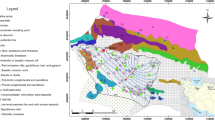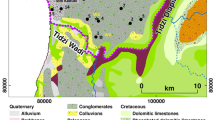Abstract
The evaluation of the long-term effects of seawater intrusion into the aquifers due to negative water balance and nitrate pollution of drinking-water quality due to human activities requires detailed knowledge of both the transport of the chemical constituents and the geochemical processes within aquifers. Hydrogeological and hydrochemical studies in the unconfined aquifer of Malia have provided the necessary data to define the areas at increased risk from these phenomena. The solution of the second Fick's low under given boundary conditions gave an estimate of the propagation of groundwater pollution by NO3 –. Additionally, in order to simulate the ion concentration changes during a period, for example a period of positive water balance or refreshening, groundwater transport and cation exchange reactions were modelled using the code PHREEQM.
Similar content being viewed by others
Author information
Authors and Affiliations
Additional information
Received: 25 July 1997 · Accepted: 4 November 1997
Rights and permissions
About this article
Cite this article
Lambrakis, N. The impact of human activities in the Malia coastal area (Crete) on groundwater quality. Environmental Geology 36, 87–92 (1998). https://doi.org/10.1007/s002540050323
Issue Date:
DOI: https://doi.org/10.1007/s002540050323




